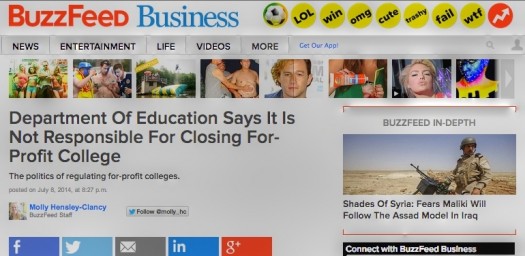In a time when more brands want their media assets to work together, Gannett joined Time Warner Inc., News Corp. and the Tribune Co. by moving to split its print assets from its digital and broadcast media. Specifically, Gannett newspapers and magazines will stand alone while its online media and broadcast units form another company.

What should practitioners take away from this? With dwindling readership, print media is not a profitable growth business, at least not in that oh so mad Wall Street Way. This is financial triage in its finest form.
PR practitioners and marketers should not be affected short term.
However, if newspapers continue to struggle thanks to less print advertising revenue, there will be a larger issue at play. Newspapers and magazines must find revenue or they will be forced to shutter their doors.
Selling out to survive

Much has been said about journalistic integrity, but newspapers have to make money to survive. Quality “objective” news is the product, but if no one underwrites the product, the newspaper business cannot sustain itself.
Conventional online advertising and subscription models (e.g. paywalls) are not succeeding. Now newspapers and magazines are forced to explore other models such as retargeting, full page advertising takeovers, and the editorially uncouth option of native advertising.
Native advertising was so controversial for The New York Times that it became a primary issue driving Jill Abramson’s dismissal earlier this year. Other brands like Forbes have embraced it, adding bloggers and pay-to-play brands with difffering levels of advertising control. For many, it’s still cool to be seen on Forbes.
Then there are the Buzzfeeds of the world. New online media brands like Buzzfeed make their money from six figure investments via native placement, but the content is highly controlled (we’ll pass on the plagiarism issue for this post).
The increasing difficulty of placing news

The sad look of an empty newsroom.
As online media strengthens and print weakens, the very nature of news is changing. Many PR pros know that there are fewer reporters and outlets that can actually assign journalists to stories.
Newspapers are doing more than tightening their belts, though. Algorithms play an increasingly important role in the news world today. Real time trends drive reporter assignments and which headlines are featured for publications like the USA Today, The Huffington Post, Mashable and The Verge.
Any PR pro who thought social media was only about posting on a Twitter and Facebook page will need to think again. Social validation of stories and ideas can make or break a story.
In that same vein, a PR pro who can provide responsive real-time information based on trends can greatly aid their ability to generate earned media impressions. Whether you call this newsjacking or just smart intelligent approaches to issues impacting your stakeholders, providing responsive information is a great way to demonstrate subject matter expertise.
In that same vein with fewer reporters and a much stronger emphasis on rich media that works on smartphones, PR pros can supply content to generate coverage. Specifically, rather than offering a straight pitch, brands can offer the media photo, graphical and video coverage to augment news stories. The media is very hungry for these types of assets as they are critical to their online success.
The very meaning of news is dramatically changing thanks to the Internet. When you combine the impact of fast trending information, paid media approaches to revenue and mobile rich media, it’s hard to ignore this shift. As such, PR pros find themselves in more of a brand journalism role. Now they must also augment the news instead of just pitching it.
What do you think about the Gannett divestiture of its online and broadcast outlets, and the long term impact on news?
Image: Michael Doss (Creative Commons)![]()

